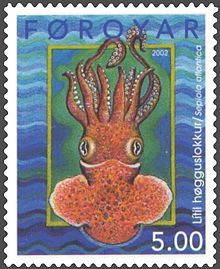Sepiola atlantica
| Sepiola atlantica | ||||||||||||
|---|---|---|---|---|---|---|---|---|---|---|---|---|

Copy from the Middelkerkebank on the Belgian continental shelf |
||||||||||||
| Systematics | ||||||||||||
|
||||||||||||
| Scientific name | ||||||||||||
| Sepiola atlantica | ||||||||||||
| d'Orbigny , 1839 |
Sepiola atlantica (in German dwarf sepia or Atlantic sepiole ) is an octopus in the family of dwarf squid (Sepiolidae). Its distribution area is in the Atlantic between Iceland and Scandinavia and extends south to the coast of Morocco .
features
The length of the mantle of Sepiola atlantica is independent of gender and is around 21 millimeters. The fins are relatively short and do not protrude beyond the coat. In the mantle cavity, the animals have paired, kidney-shaped luminous organs ( photophores ) on both sides of the ink bag . The arms have two rows of suction cups, two of the arms are also equipped with four to eight rows of small suction cups on the tips of the tentacles. The two tentacles have eight suction cups.
The males have a hectocotylus , i.e. a tentacle that has been modified for mating . This is the left dorsal arm, on which a fleshy pad is formed. The copulatory apparatus itself consists of an enlarged horn with lateral lobes. The dorsal suction cup series has three to four significantly enlarged suction cups with swollen foot areas, then three or four greatly reduced suction cups and finally three to five very enlarged suction cups. In the distal half of the hectocotylus is strongly curved.
Sepiola atlantica differs from similar species mainly in the distribution of the suction cups on arm IV and in the position and shape of the luminous organs inside the mantle cavity.
distribution and habitat
The distribution area of Sepiola atlantica extends in the north-eastern Atlantic from 65 to 35 ° N or from Iceland via the Faroe Islands and western Norway to Morocco . In the Mediterranean this kind has so far been detected only once.
The animals prefer the continental shelf to the continental breakup. They mainly live near the sea floor (epibenthic), but are also regularly caught in middle sea layers.
Way of life
The species probably does not have strict breeding times. The populations accordingly consist of animals of different ages and young animals can be caught throughout the year with a slightly higher number in summer from April to August.
use
The animal is suitable for consumption and is caught regularly, especially in Northern Europe, but there are no specific catch figures for this species. The little squid is often sold as a "little sprutte".
literature
- P. Jereb, CFE Roper (Ed.): Cephalopods of the world. An annotated and illustrated catalog of cephalopod species known to date. Volume 1. Chambered nautiluses and sepioids (Nautilidae, Sepiidae, Sepiolidae, Sepiadariidae, Idiosepiidae and Spirulidae). FAO Species Catalog for Fishery Purposes. No. 4, vol. 1. Rome, FAO 2005; Pp. 159–160 ( full edition )
Web links
- Sepiola atlantica inthe IUCN 2013 Red List of Threatened Species . Listed by: Barratt, I. & Allcock, L., 2009. Retrieved February 15, 2014.
Individual evidence
- ↑ Sven Gehrmann: The fauna of the North Sea: Lower animals and vertebrates . epubli GmbH, Berlin 2011, ISBN 3844202463 , pp. 208-209.
- ↑ Fritz Gosselck, Alexander Darr, Jürgen H. Jungbluth, Michael L. Zettler (2009): Trivial names for mollusks of the sea and brackish water in Germany (Polyplacophora, Gastropoda, Bivalvia, Scaphopoda et Cephalopoda). Mollusca 27 (1): 3-32.
